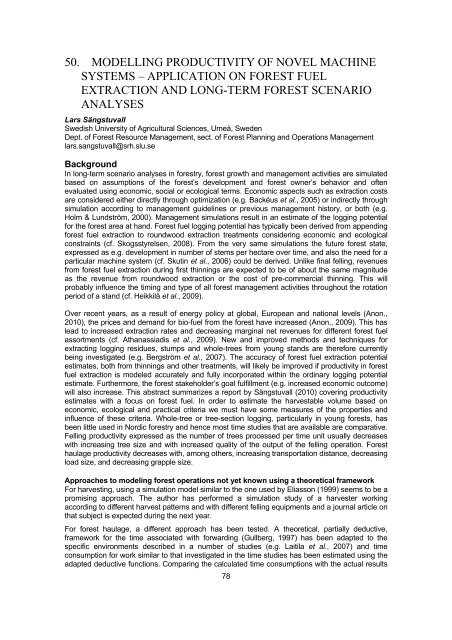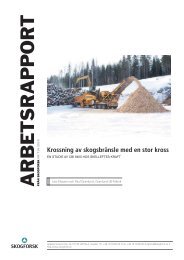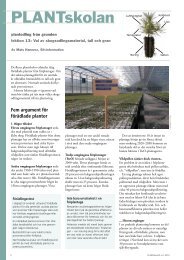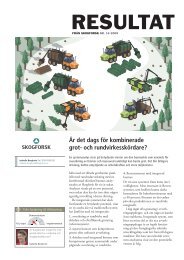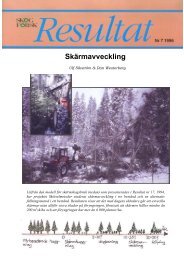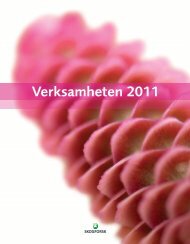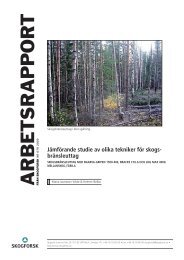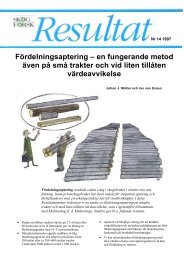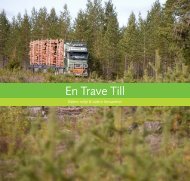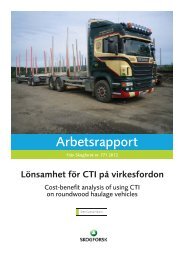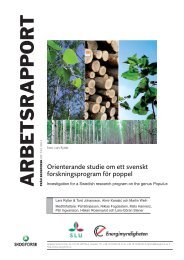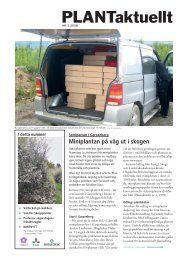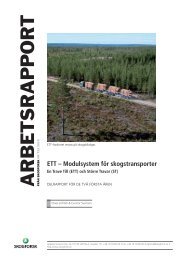Download pdf - Skog og landskap
Download pdf - Skog og landskap
Download pdf - Skog og landskap
Create successful ePaper yourself
Turn your PDF publications into a flip-book with our unique Google optimized e-Paper software.
50. MODELLING PRODUCTIVITY OF NOVEL MACHINE<br />
SYSTEMS – APPLICATION ON FOREST FUEL<br />
EXTRACTION AND LONG-TERM FOREST SCENARIO<br />
ANALYSES<br />
Lars Sängstuvall<br />
Swedish University of Agricultural Sciences, Umeå, Sweden<br />
Dept. of Forest Resource Management, sect. of Forest Planning and Operations Management<br />
lars.sangstuvall@srh.slu.se<br />
Background<br />
In long-term scenario analyses in forestry, forest growth and management activities are simulated<br />
based on assumptions of the forest’s development and forest owner’s behavior and often<br />
evaluated using economic, social or ecol<strong>og</strong>ical terms. Economic aspects such as extraction costs<br />
are considered either directly through optimization (e.g. Backéus et al., 2005) or indirectly through<br />
simulation according to management guidelines or previous management history, or both (e.g.<br />
Holm & Lundström, 2000). Management simulations result in an estimate of the l<strong>og</strong>ging potential<br />
for the forest area at hand. Forest fuel l<strong>og</strong>ging potential has typically been derived from appending<br />
forest fuel extraction to roundwood extraction treatments considering economic and ecol<strong>og</strong>ical<br />
constraints (cf. <strong>Sk<strong>og</strong></strong>sstyrelsen, 2008). From the very same simulations the future forest state,<br />
expressed as e.g. development in number of stems per hectare over time, and also the need for a<br />
particular machine system (cf. Skutin et al., 2006) could be derived. Unlike final felling, revenues<br />
from forest fuel extraction during first thinnings are expected to be of about the same magnitude<br />
as the revenue from roundwood extraction or the cost of pre-commercial thinning. This will<br />
probably influence the timing and type of all forest management activities throughout the rotation<br />
period of a stand (cf. Heikkilä et al., 2009).<br />
Over recent years, as a result of energy policy at global, European and national levels (Anon.,<br />
2010), the prices and demand for bio-fuel from the forest have increased (Anon., 2009). This has<br />
lead to increased extraction rates and decreasing marginal net revenues for different forest fuel<br />
assortments (cf. Athanassiadis et al., 2009). New and improved methods and techniques for<br />
extracting l<strong>og</strong>ging residues, stumps and whole-trees from young stands are therefore currently<br />
being investigated (e.g. Bergström et al., 2007). The accuracy of forest fuel extraction potential<br />
estimates, both from thinnings and other treatments, will likely be improved if productivity in forest<br />
fuel extraction is modeled accurately and fully incorporated within the ordinary l<strong>og</strong>ging potential<br />
estimate. Furthermore, the forest stakeholder’s goal fulfillment (e.g. increased economic outcome)<br />
will also increase. This abstract summarizes a report by Sängstuvall (2010) covering productivity<br />
estimates with a focus on forest fuel. In order to estimate the harvestable volume based on<br />
economic, ecol<strong>og</strong>ical and practical criteria we must have some measures of the properties and<br />
influence of these criteria. Whole-tree or tree-section l<strong>og</strong>ging, particularly in young forests, has<br />
been little used in Nordic forestry and hence most time studies that are available are comparative.<br />
Felling productivity expressed as the number of trees processed per time unit usually decreases<br />
with increasing tree size and with increased quality of the output of the felling operation. Forest<br />
haulage productivity decreases with, among others, increasing transportation distance, decreasing<br />
load size, and decreasing grapple size.<br />
Approaches to modeling forest operations not yet known using a theoretical framework<br />
For harvesting, using a simulation model similar to the one used by Eliasson (1999) seems to be a<br />
promising approach. The author has performed a simulation study of a harvester working<br />
according to different harvest patterns and with different felling equipments and a journal article on<br />
that subject is expected during the next year.<br />
For forest haulage, a different approach has been tested. A theoretical, partially deductive,<br />
framework for the time associated with forwarding (Gullberg, 1997) has been adapted to the<br />
specific environments described in a number of studies (e.g. Laitila et al., 2007) and time<br />
consumption for work similar to that investigated in the time studies has been estimated using the<br />
adapted deductive functions. Comparing the calculated time consumptions with the actual results<br />
78


